The ideal overland two-week itinerary for Uzbekistan and Tajikistan, including best places to visit, where to stay, travel times, and all the other delectables you need to sort out an epic Central Asian adventure.
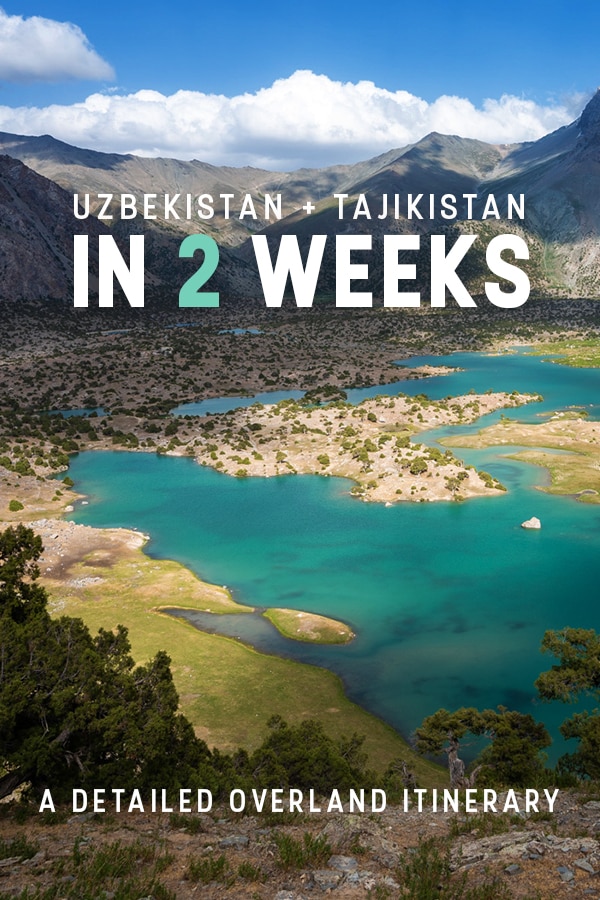
Pin it!
If you had to choose between dizzyingly tiled Timurid architecture and dazzlingly turquoise alpine lakes, which would you choose?
How about… both?
Traveling overland between Central Asian countries used to be time consuming, but things are changing in the ‘stans these days. New border crossings are open to tourists, e-visas and visa-free regimes are a thing, and tourist infrastructure is rapidly expanding.
Overland travel in Central Asia has never been easier. Head on over and see for yourself!
Index
- Why Uzbekistan and Tajikistan?
- Two week itinerary for Uzbekistan and Tajikistan
- Which direction?
- Uzbekistan
- Day 1: Tashkent
- Day 2: Tashkent (overnight to Bukhara)
- Day 3: Bukhara
- Day 4: Bukhara (night to Samarkand)
- Day 5: Samarkand
- Border crossing: Uzbekistan to Tajikistan
- Tajikistan
- Travel tips
- Resources
Why Uzbekistan and Tajikistan?
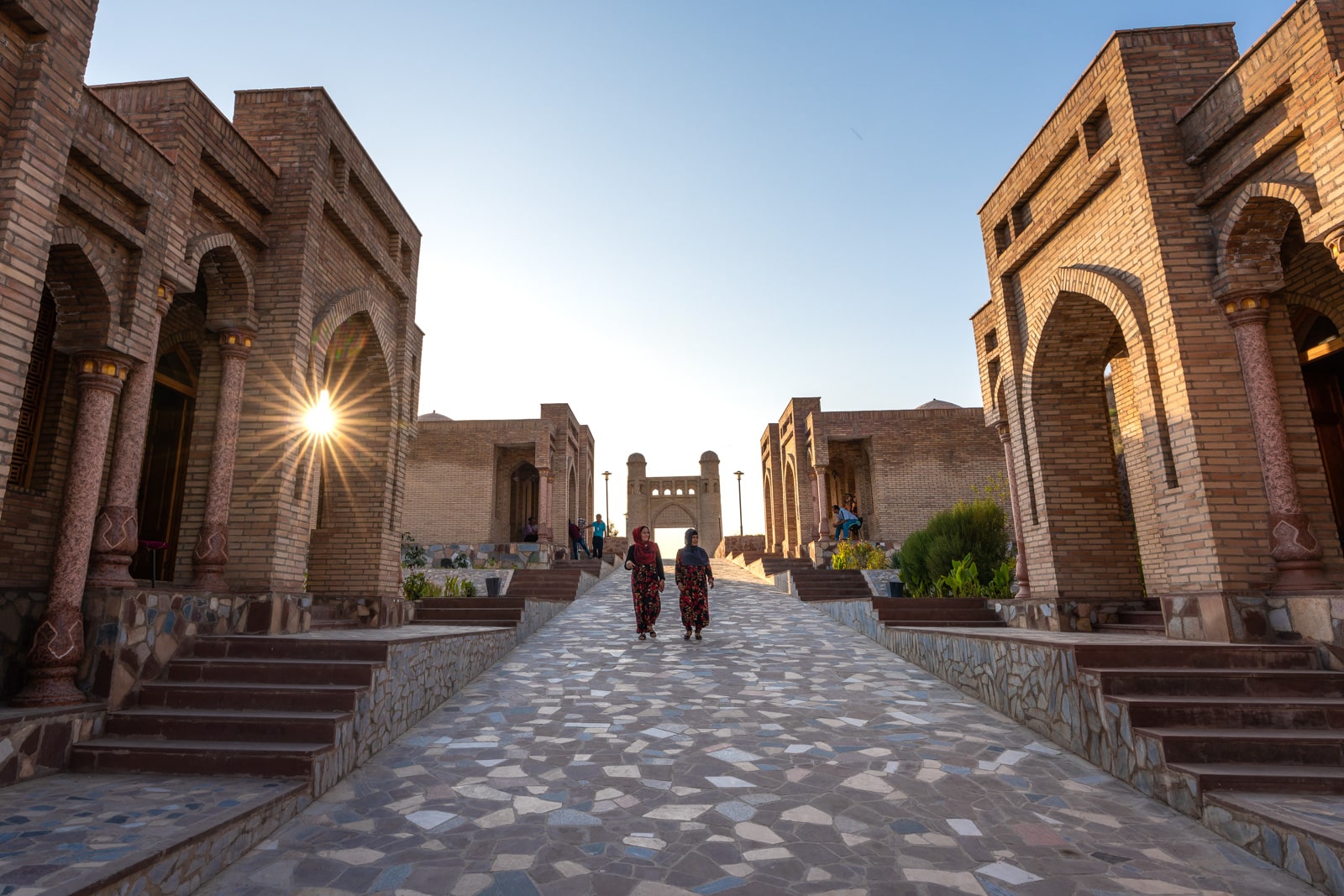
Hisor Fort, Dushanbe, Tajikistan
Choosing which ‘stan to travel is difficult, I know. I’ve traveled every ‘stan except Turkmenistan, and I love them all for different reasons.
… but if we’re talking accessibility and getting a first taste of Central Asia, Uzbekistan and Tajikistan are the perfect combination. Your eyeballs are guaranteed to pop when feasting on Uzbekistan’s architecture, and Tajikistan’s mountainous landscapes are equally delicious.
Best of all, both countries’ people are immensely friendly. Uzbeks aren’t afraid to strike up a good conversation, and Tajiks are the most hospitable people I’ve encountered in Central Asia. Though sights and views are the first draw to these countries, hospitality is what keeps people coming back.
Try this Uzbekistan and Tajikistan itinerary, see how it goes. I’ll bet a hot plate of plov this won’t be your last trip to Central Asia.
Two-week itinerary for Uzbekistan and Tajikistan. Overland only!

Driving Tajikistan’s Fann Mountains
Which direction?
Either direction works. Which you choose depends on:
- Your entry point. Flights to Tashkent are cheaper than those to Dushanbe. However, Tajikistan is well connected to Kyrgyzstan if you want to enter from that direction via the Pamir Highway (Bishkek is another cheap airport).
- Travel preferences. Tajikistan’s infrastructure is less developed than Uzbekistan. Its trekking can be strenuous. Uzbekistan will be relaxing after Tajikistan! On the flip side, Tajik people are wonderful; Uzbekistan to Tajikistan is ideal for increasing hospitality.
- Aversion to tourists. Uzbekistan is more touristic than Tajikistan; you’ll see package tour buses and twirling Instagirls these days. If groups of tourists frustrate you, start in Uzbekistan and end in offbeat Tajikistan.
I chose to write from Uzbekistan to Tajikistan since that’s the route I recently followed during a trip sponsored by USAID.
Uzbekistan

Khast Imam complex, Tashkent, Uzbekistan
Tashkent: a capital introduction
Your journey begins in Tashkent, as much a crossroads of culture now as the region was in the Silk Road era. What the city lacks in sights it compensates for with intriguing blends of Uzbek and Soviet culture. It’s an easy first stop: many locals speak English, infrastructure is good, and the city’s boulevards are tree-lined and orderly.
Where to stay in Tashkent
- Budget: European Backpacker & Sakura Hostel is centrally located and includes free breakfast. Book a bed at European Backpacker.
- Mid-range: Hotel Uzbekistan is the epitome of Soviet architecture and smack in the middle of the city. Book a room at Hotel Uzbekistan.
- Luxury: Ichanqala Hotel is traditionally decorated, but equipped with comfortable modern amenities. Book a room at Ichanqala Hotel.
Want to dig into Tashkent? Consider booking a walking tour run by Tashkent locals for a more off the beaten track experience.

Broadway Street, Tashkent
Day 1 | Tashkent
Your first taste of Tashkent: bazaars, Qurans, and a side of… beer?!
Places to visit in Tashkent
Chorsu Bazaar: Housed in a massive white geodesic dome, the bazaar is open 24/7. Chat up vendors, try some samples—they have everything from horse sausage to dried apricots—and make sure to head upstairs for a view of the market maze.
Khast Imam Complex: The “Mr. Imam” complex is new by Uzbek standards, but beautiful nonetheless. Savor mosque ceilings, peruse the Barak Khan Madrassa-cum-souvenir shop (lots of these in Uzbekistan), and don’t miss the ticketed central library, where one of the oldest Qurans in the world is on display.
Rooftop bar of Hotel Uzbekistan: Even if you don’t drink, a trip to the bar around sunset guarantees fantastic views of the city.
Also read: 40 photos of Uzbekistan to get you Silk Road dreamin’
Amir Timur Square: Green central square containing Amir Timur’s statue—you know, that dude who conquered most of the Muslim world—which is striking against Hotel Uzbekistan.
Broadway Street: Locals hang out here come evening. Follow your feet along bright streets lined with sweet treats, carnival games, and art on display.
Independence Square: Fountain-filled and ringed by brutalist architecture, this impressive square is also within walking distance of several parks.
Did you get your ticket?!
Make sure you have your overnight train ticket from Tashkent to Bukhara for tomorrow evening! As of 2019, your options include:
- Afrosiyob fast train around 18:50 (4 hours)
- Normal train around 20:30 or 22:15 (8 hours)
It’s possible to buy tickets on Uzbekistan Railways’ website… if you can read Russian. Your hotel can help you book a train ticket, or you can use Advantour to book train tickets in Uzbekistan ahead of time—you’ll need another overnight ticket from Bukhara to Samarkand. Make sure you book a bed since you’ll be traveling overnight.
Also read: 60+ things to know before traveling to Uzbekistan

Alisher Navoi Metro station
Day 2 | Tashkent
A day chock full of vats of fats and watery ways.
Places to visit
Metro stations: Tashkent’s metro is a feast for the eyes, but until 2018 the feast was for passenger’s eyes only. These days you can ride the metro all day (only US$0.15 per ride!) and snap away at cavernous ceilings, colorful mosaics, and grand chandeliers. Just avoid taking photos of guards or tunnels. I most enjoyed Alisher Navoi/Pakhtakor and Kosmonavtlar stations.
Central Asian Plov Center: Uzbekistan’s national dish contains rice, meat, vegetables, chickpeas, raisins, and a (un)healthy dose of animal fat. This massive center is the place to go for plov in Tashkent, evidenced by locals inevitably queuing outside. Watch men prepare vats of plov over fires outside, then sit inside and order your plov of choice: with or without egg and/or horse sausage, kazy.
Canals: The arterial canals running through Tashkent are serene places to observe daily Uzbek life away from the center city hustle.
Minor Mosque: An architectural highlight. Tourists can’t enter during prayer times, but you can wander its white walls at other times of day.

Tashkent train station
Getting to Bukhara by train
Hopefully you have your ticket already! Tashkent train station is in the south, next to the Tashkent metro station. Arrive at least half an hour early for security screening.
When the train arrives you’ll have time to load your belongings and get settled. You’ll receive sheets if you booked a bed—get settled and rest up, because tomorrow you’ll wake up in Bukhara!
Extra things to do in Tashkent
- Alay Bazaar (Oloy Bozori) is a marketplace for Tashkent’s middle class. This columned open-air bazaar is more manicured than Chorsu.
- Navoi Opera Theater hails from the Soviet Era. How often can you see an opera in a grand theater for less than US$10?
- Tashkent House of Photography features contemporary local artists.
Transportation times from Tashkent
- Train to Samarkand: 2-4 hours
- Plane to Samarkand: 1 hour
- Shared taxi to Samarkand: 4 hours
- Train to Bukhara: 6-8 hours (normal train), 4 hours (Afrosiyob)

Kalyan Mosque in Bukhara
Bukhara: center of thoughts
In the days of yore, Bukhara was the gathering place for artists, scientists, merchants, and everyone in between. Ethnically more Tajik than Uzbek, this city was one of the major centers of Islamic theology more than 1,000 years ago.
Where to stay in Bukhara
- Budget: Joyran Hostel is clean and close to the center with friendly hosts. Book your stay at Joyran Hostel.
- Mid-range: Chor Minor Hotel is beautifully decorated and in the old part of town. Book a room at Chor Minor Hotel.
- Luxury: Komil Boutique Hotel is a stunning heritage hotel with parts dating back to the 19th century! Book a room at Komil Boutique Hotel.

Bolo Hauz Mosque
Day 3 | Bukhara
Minarets, mosques, and madrassas, oh my! Today is all about Bukhara’s historic highlights.
Places to visit in Bukhara
Po-i-Kalyan: Bukhara’s most famous square contains multiple sights. Most obvious: Kalyan Minaret, visible throughout Bukhara. This cleverly built 12th century minaret was the first place Uzbekistan’s quintessential blue tiles were used. You can’t enter, but it’s at the entrance to the more recent Kalyan Mosque, whose sprawling courtyard and cavernous interior are open to visitors. Mir-i-Arab madrassa sits opposite the mosque, but it’s still active and not open to tourists.
Chasmai Mirob: An overpriced restaurant with slow service… but wait! The views from this restaurant over Po-i-Kalyan are worth an expensive tea (or beer if you’re cheeky and want to drink while admiring Islamic monuments).
Bolo Hauz Mosque: Opposite the fortress, solid wooden columns so high your neck will ache combined with hand painted details on faraway ceilings make this mosque unique. You can enter if it isn’t prayer time.
Chor Minor: A cute little gatehouse with four minarets—hence the name chor minor—it’s removed from the old city center, and thus quieter. Each minaret is decorated in a different style; appreciate them from the roof after paying a fee at the souvenir shop inside.
Lyabi Hauz: Hauz means pond in Persian, and that’s exactly what this place is: a collection of madrassas around a central pond. Though it’s consumed by tourism, it’s a stunning place to sit and enjoy a cup of tea or a meal by the glittering pool.
Did you get your ticket?!
Make sure you have your train ticket from Bukhara to Samarkand for tomorrow! As of 2019, your options include:
- Afrosiyob fast train around 15:50 (1.5 hours)
- Normal train around 21:45 or 23:00 (4 hours)
It’s possible to buy tickets on Uzbekistan Railways’ website, but you need to know Russian to do so. Your hotel can help you book a train ticket, or you can use Advantour to book train tickets in Uzbekistan.

Residential streets of Bukhara
Day 4 | Bukhara
Time to venture beyond old Bukhara’s center!
Places to visit
Chor Bakr necropolis: 6 kilometers outside the city lies a 16th century necropolis. Banned as a religious site in the Soviet era, it’s since returned to its original significance. It’s a peaceful place away from the touristic bits of Bukhara. A taxi (4,000 som) or local bus is necessary to reach the necropolis.
Ismail Somoni (Samanid) mausoleum: The oldest surviving Islamic monument in Central Asia is also one of Bukhara’s oldest monuments. Completed in 905 AD, it’s said it escaped Genghis Khan’s razing because it was buried in mud before his arrival. The mausoleum is surrounded by a quiet park.
Chashma Ayub Mausoleum: Translated as “Job’s Spring”, legend has it the prophet Job (Ayub in the Quran) struck his staff upon the ground and created a spring at this spot. Located near the Samanid mausoleum, a Timurid mausoleum now stands over the well. Visitors can drink the well water, claimed to have healing properties.
How to get to Samarkand by train
The train station, Kagan, is 10 minutes east of the old town. Arrive at least half an hour early to go through security screening.
Whichever train you choose, you’ll arrive in Samarkand in the evening or night. Make sure you book a hotel ahead of time!
Extra things to do in Bukhara
- Ark of Bukhara: This massive fortress in the middle of Bukhara contains several small museums. Heavily restored—most of it was destroyed in the 1920s—its museums are not particularly well presented. It’s worth a look only if you have time.
- Fayzulla Khujayev House: The house of a wealthy 19th century merchant away from the main tourist drag, it’s a centuries-old glimpse into the lives of Bukhara’s elite.
- Sitora-i Mokhi Khosa: Summer palace for some of Bukhara’s last rulers to the east of the city. Opulent works of architecture line a large pool; colorful interiors illustrate the common fusion of European and Central Asian ideas at that time.
Transportation times from Bukhara
- Train to Samarkand: 2-3 hours
- Shared taxi to Samarkand: 4 hours
- Bus to Samarkand: 5-6 hours
- Train to Tashkent: 6.5 hours
- Bus to Urgench (Khiva): 8 hours
- Shared taxi to Urgench (Khiva): 7 hours

Gur-e-Amir mausoleum
Samarkand: Uzbekistan’s crown jewel
Bukhara was the gathering place of minds, but Samarkand is where the action happened: it was the capital of Timur’s empire. Home to Uzbekistan’s most iconic sights, you’re guaranteed to be oohing and ahhing all day. Get ready to peel your jaw off the floor.
Samarkand ain’t the same out of context. Booking a walking tour to ensure you get the full story behind this Silk Road city.
Where to stay in Samarkand
- Budget: B&B Bahodir is a charming family-run guesthouse with garden close to the center. Book a room at B&B Bahodir.
- Mid-range: Centrally located Jahongir B&B’s staff speak excellent English and it has fast wifi. Book a room at Jahongir B&B.
- Luxury: Bibikhanum Hotel can’t be beat for views—it’s right across from Samarkand’s biggest mosque. Book a room at Bibikhanum Hotel.
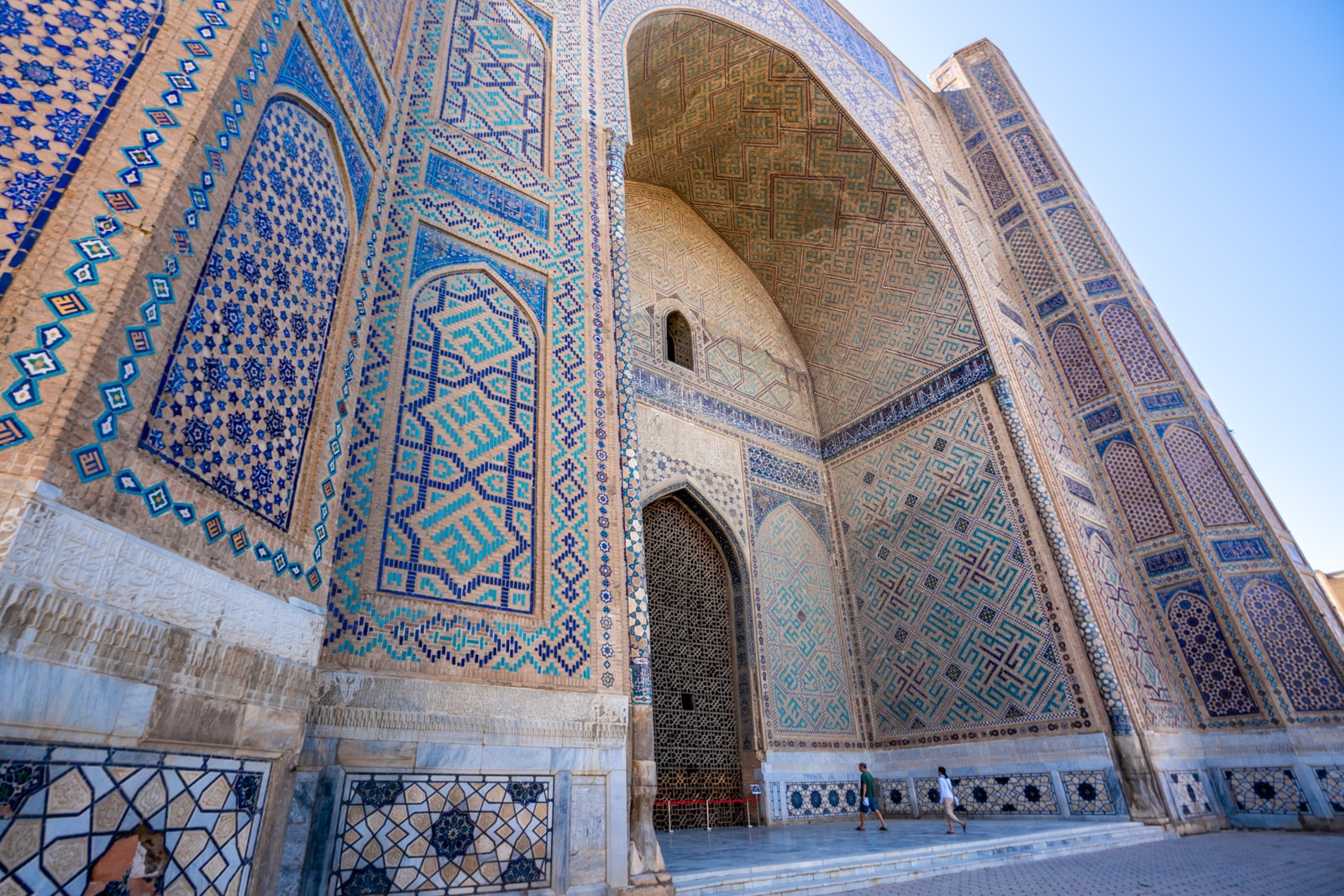
Bibi Khanum Mosque
Day 5 | Samarkand
It’s Timurid time! You can easily walk to all of Samarkand’s major sites in a day; make sure your camera is charged and ready.
Tip: It’s worth getting up before sunrise in Samarkand. Streets are quiet, and many buildings are lit at night; it’s magical to see them illuminated without tourist crowds.
Places to visit in Samarkand
Gur-e-Amir: Timur’s mausoleum is a gilded sight to behold. Blue mosaics paint the outside, while gold leaf and calligraphic script glow inside. All of the graves are actually in a closed vault beneath the mausoleum; the tombs inside are place markers for graves below.
Registan: Meaning “desert” in Persian, Uzbekistan’s most famous complex is home to three no longer functional madrassas: Ulugbek, Shirdor and Tilla Kari, constructed between the 15th and 17th Tilla Kari’s mosque has the most opulent ceiling in all of Uzbekistan, so don’t miss it!
Bibi Khanum Mosque: Once the largest mosque of its time, this massive building honoring Timur’s wife is crumbling—its construction was too rushed! Gradually it’s being restored, but for now you can enter the mosque through a massive crack in its walls.
Siyob Bazaar: Next to the Bibi Khanum mosque, this busy bazaar offers everything from produce to sweets to hot tea ‘round back. Try the varieties of sweet Samarkand halwa sold near the entrance.
Shah-i-Zinda: This narrow necropolis is a fast favorite of many. Turquoise tiles line its singular alley, home to dozens of tombs including that of Kusum Ibn Abbas, the prophet Muhammad’s cousin. Some tombs date all the way back to the 11th century! It’s best visited around sunset or sunrise when the tour groups are gone. Enter from the surrounding cemetery, open 24/7.
Local beer at Labi G’or: Treat yourself after a long day to a local brew at this upper level restaurant near the Registan. The food is overpriced, but this is one of the most central places to get fresh Samarkand beer.
Extra things to do in Samarkand
- Khazret Khyzyr Mosque: This mosque near Shah-i-Zinda was first built in the 7th century (then razed by Genghis and restored in the 19th century). It sits on a pretty hilltop overlooking the city.
- Ulugh Beg’s Observatory: Ulugh Beg, one of the most prominent astronomers/scientists/architects/minds from Uzbekistan’s history, used to conduct astronomical research here in the 15th It was one of the most impressive observatories in the Islamic world.
- Imam al-Bukhari Mausoleum: An Islamic scholar’s mausoleum in a complex filled with leafy trees and intricate woodwork. You’ll need a taxi to reach the mausoleum, but it’s worth it to escape crowds.
Transportation times from Samarkand
- Train to Tashkent: 2-4 hours
- Train to Bukhara: 2-3 hours
- Shared taxi to Bukhara: 4 hours
- Bus to Bukhara: 5-6 hours
- Train to Urgench (Khiva): 12 hours
Border crossing: Uzbekistan to Tajikistan
Previously closed to foreigners, this overland border crossing between Samarkand and Panjakent is now incredibly easy to cross. The entire process took less than one hour! The ‘stans are making an effort to ease overland travel, and it shows.
Prepare ahead of time
If relevant, have printed copies of your e-visas. Uzbek border officials sometimes ask for hotel registration slips, but in August 2019 they just checked to see if I had any, not the dates of the slips.
Getting to the border from Samarkand
- Public transport: Transport to the border leaves from Kaftarxona bus station. A shared taxi is around 20,000 som/person, while marshrutky are 5,000 som/person. It’s a 45-minute drive to the border.
- Private transport: Your hotel can arrange a private taxi to the border.
Crossing the Uzbekistan – Tajikistan border
Once at the border, go to the Uzbek immigration office (entrance to the right). Bags are scanned, then at the immigration desks they’ll ask for your passport, visa, and maybe registration slips, then stamp you out of Uzbekistan. No manual searching of bags, a welcome change from when I exited Uzbekistan in 2016.
After a short walk to the Tajik side, there’s no security, just a check and stamp of your Tajikistan visa with a friendly “welcome to Tajikistan!”
Moneychangers lurk on either side of the border. US dollars are easiest to exchange, but they also accept Uzbek som and Tajik somoni.
How to get to Panjakent from the border
- Public transport: Shared taxis run from the border post once full. 10 somoni per person for the 20 minute drive.
- Private transport: Your hotel in Panjakent can arrange a border pickup.

Useful? Pin it!
Tajikistan

Old Panjakent
Tip: Public transportation in Tajikistan is not always straightforward. If short on time or inexperienced, I highly recommend organizing a private car through a tour company for part of your trip. Paramount Journey is a reputable Tajik tour company who can organize your transportation. Arrange Fann Mountains transport with Paramount here.
Panjakent: an ancient welcome to Tajikistan
Panjakent was once the capital of the Sogdian Empire, a Zoroastrian civilization well predating Islam in the region. Though most people travel to Tajikistan for trekking, there are several ancient sites in the area worth visiting on your way to the mountains.
Where to stay in Panjakent
- Budget: Umariyon Hotel has private rooms and dorm beds, including excellent breakfast. Book a stay at Umariyon.
- Mid-range: Hotel SUGD has helpful staff, free breakfast, and good amenities. Book a room at Hotel SUGD.

Panjakent bazaar
Day 6 | Panjakent
Part of your day is for crossing from Uzbekistan to Tajikistan, but it’s so easy you should still have time for checking out some ruins and relics.
Tip: ZTDA, the Zerafshan Tourism Development Association, has an office in Panjakent. They can provide all kinds of information, and help arrange transportation, treks, and homestays throughout the Fann Mountains. Consider booking private transportation here if short on time. Ask specifically about: Panjakent to Haft Kul (Nofin), Haft Kul to Artuch, Vertical Alauddin to Dushanbe.
Places to visit around Panjakent
Sarazm: A stone’s throw away from the border crossing are the UNESCO-listed ruins of Sarazm. More than 5,000 years old, they’re remains of the first agricultural society in Central Asia. A remarkably tall human skeleton, dubbed the “Princess of Sarazm”, was found here with some of her ornaments. Archaeologists also found artifacts indicating ancient trading routes stretching as far as modern day Iran and Pakistan.
Panjakent Bazaar: This bazaar has a beautiful central building ringed by brick archways. It’s a good place to stock up on trekking snacks like nuts and dried fruits, or get your first taste of Tajik hospitality.
Old Panjakent: The 1,500+ year old ruins of ancient Panjakent are outside the city, accessible by taxi or hitchhiking. The hilltop site spans several kilometers; roam through it at your leisure. Here archaeologists found remarkably well-preserved frescoes. They’ve since been relocated to the Rudaki Museum in Panjakent, the National Museum in Dushanbe, and the Hermitage in St. Petersburg, Russia. You can see copies in the small museum at the Old Panjakent entrance.
Tip: Panjakent is the best place to buy food for trekking in the Fann Mountains, and the only place in the Fann Mountains to find gas canisters for camping stoves (ZTDA office). Stock up.
Transportation times from Panjakent
- Taxi to Dushanbe: 5 hours
- Taxi to Khujand: 7-10 hours
- Taxi to Samarkand border post: 20 minutes
Also read: 10 things to do to prepare for travel to Tajikistan
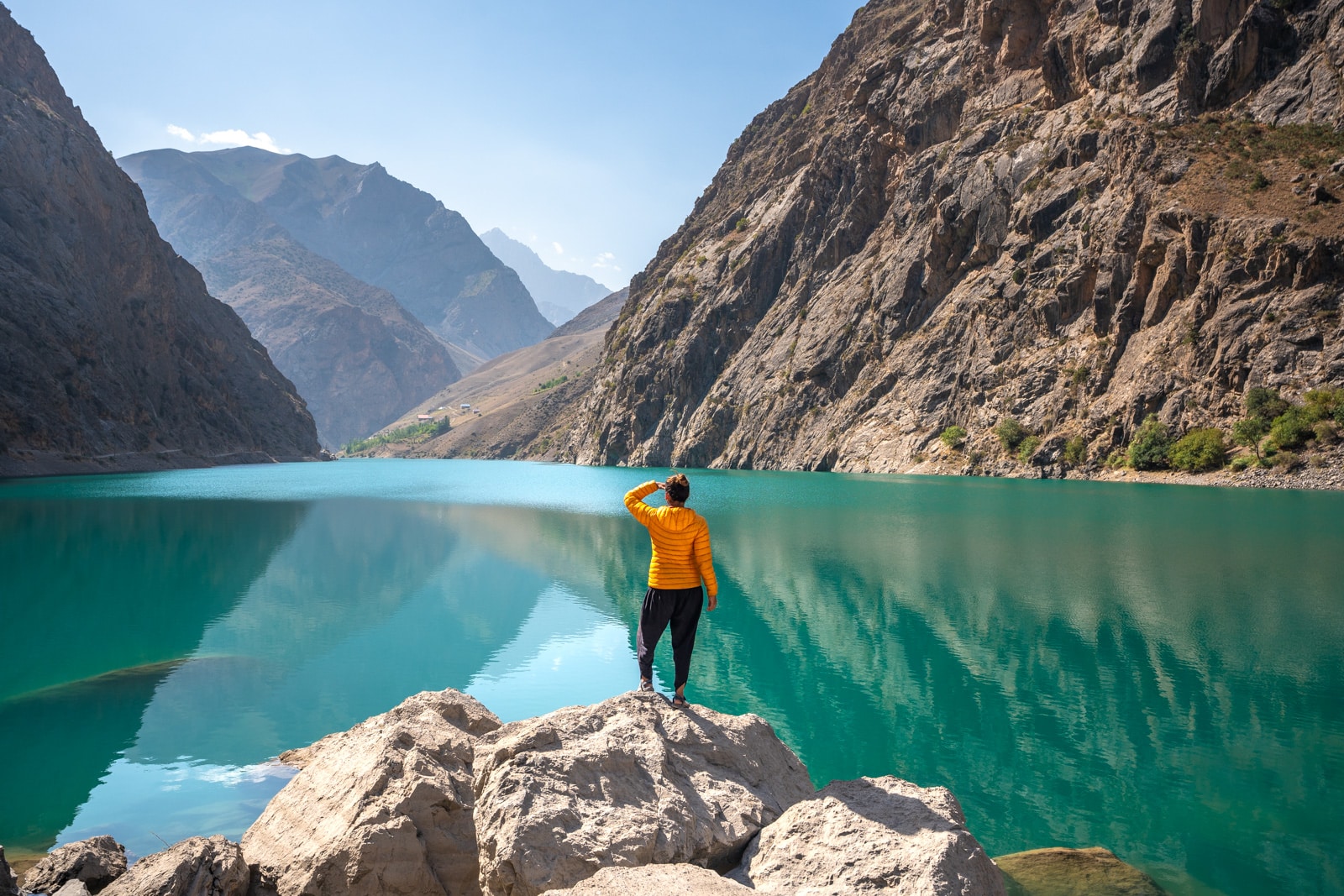
Nofin, the fourth Haft Kul Lake
Haft Kul: seven teary lakes
Seven small lakes make up the Haft Kul, “seven lakes”, in northwest Tajikistan. Legend says they’re the tears of the seven daughters of a missing man. Science says they were created after earthquakes altered the Shing River’s course.
Whichever version you prefer, the Haft Kul road is one of Tajikistan’s most accessible treks; the perfect introduction to Tajikistan’s natural beauty.
Where to stay in Haft Kul
Jumaboy’s homestay (+992 92 636 6748) also known as Three Juniper Branches or Najmiddin homestay, is the place. Run by a friendly family, the homestay near the fourth lake, Nofin, is a peaceful oasis next to a trickling stream. Beds are US$12 per person including breakfast, pitching a tent is US$4. Lunch and dinner are US$7. Prices are negotiable.
Other homestays exist in Padrud village (between the 4th and 5th lakes) and around Marguzor, the 6th lake.
Otherwise, you can camp anywhere you find a grassy or open patch—the seventh lake is your best bet.
Tip: For more specifics on the Haft Kul and trekking options around, check this guide from Adventures of Lil Nicki.

The third lake
Day 7 | Haft Kul
To the seven lakes! Getting to the Haft Kul can be as easy or as strenuous as you like—you decide how far to trek.
Getting to the Haft Kul from Panjakent
- Private transport: Private cars and 4x4s can be hired through the ZTDA office, or with the help of your hotel. If pressed for time, I recommend this—it’s easy to lose a lot of time figuring out transport in Tajikistan. This will save you time when returning from Haft Kul.
- Public transport: Marshrutky and UAZ (Soviet minibuses) from Panjakent leave from outside the bazaar. They’re 35 som for a 2.5 hour drive. They drive to different locations in Haft Kul; you may have to trek to reach the fourth lake. Hitchhiking is also an option, though local drivers expect money for fuel.
- Trekking: It’s 6-8 hours’ walking to the seventh lake from Shing village, accessible by public transport from Panjakent.
Once you’ve reached your desired sleeping spot, put away your belongings and enjoy the surroundings! Aside from the azure lakes, there are plenty of villages to wander through, with many kind locals happy invite travelers for tea.

Trek to the seventh lake
Day 8 | Haft Kul
Today is for trekking to the final lake of Haft Kul: Hazor Chashma, thousand springs.
From Jumaboy’s homestay near the fourth lake it’s about 12 km to the seventh lake. The slope is gentle, the altitude low (the seventh lake is around 2,400 m/7870 ft), so you won’t be heaving too hard. It will take you a full day to do the entire hike with stops.
Jumaboy’s homestay can pack lunch (US$4/person). A Steripen is useful for purifying water while you walk. Get your Steripen here.
Also read: 70 inspiring photos of Western Tajikistan

Bibikhonat Lake along the Lakes Loop
Lakes Loop: the finest of the Fann Mountains
The collection of lakes near Artuch are some of the most beautiful scenery the Fann Mountains have to offer. You’ll do a one-way version of the “Lakes Loop”: a popular route starting from Artuch alplager, passing Kulikalon Lake, and ending near a lake named Alauddin.
I promise you’ve never seen so many shades of blue, even if you have been to the Haft Kul. The panoramic views are guaranteed to amaze; if not, I’ll carry you down the mountain myself.
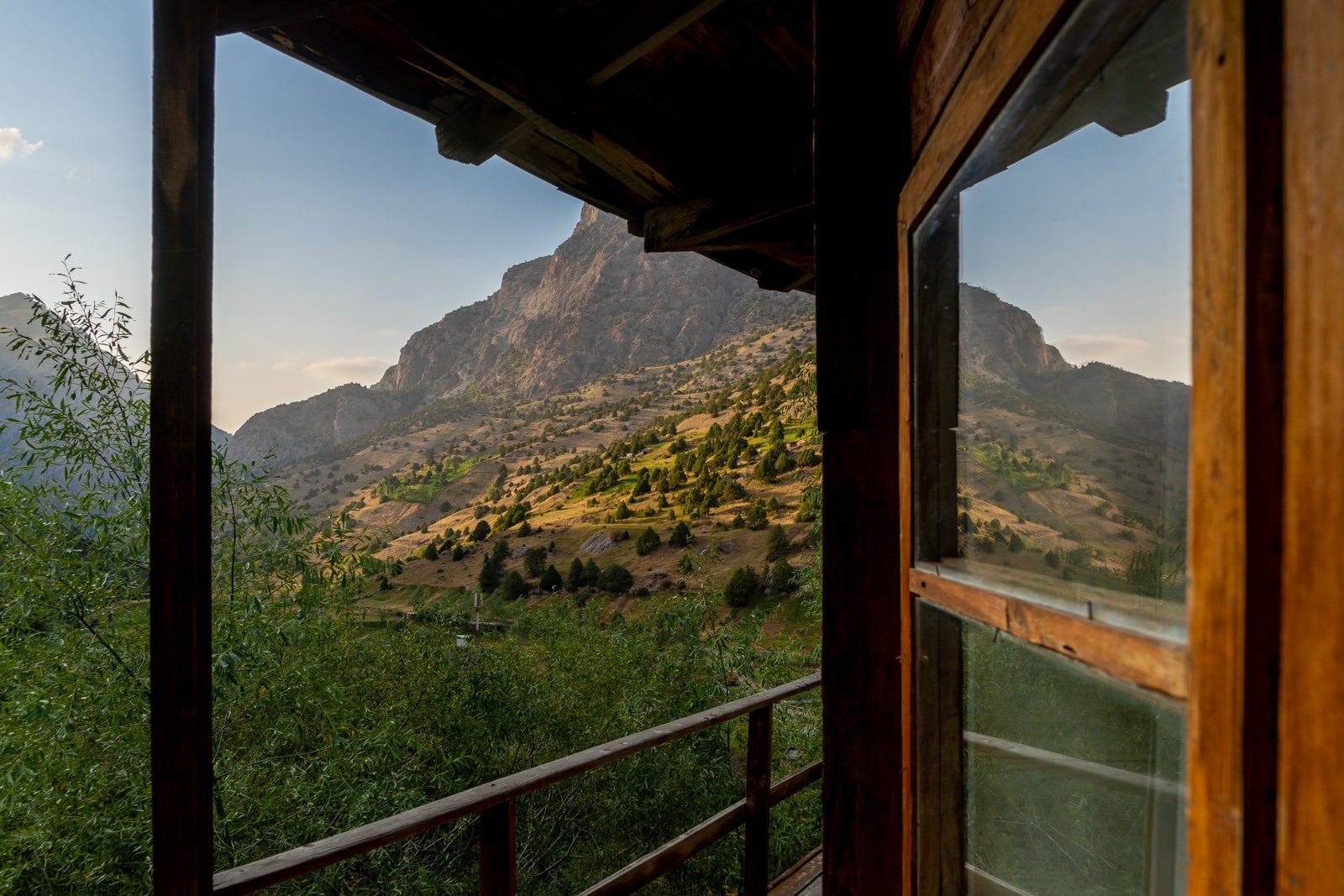
Artuch Camp
Day 9 | Lakes Loop: Haft Kul to Artuch
It’ll take a full day to reach Artuch Camp, locally known as alplager (Russian for mountain camp) or simply lager, from Haft Kul.
Getting to Artuch Camp is a long day of travel if going by public transport. Leave as early as possible to ensure you have enough time to find rides. Don’t be afraid to hitchhike if you find someone going in the right direction.
If going by private transport, you have the freedom to stop at several historic monuments along the way, mentioned below.
Where to stay in Artuch
- Artuch Camp, AKA Artuch alplager, is where many trekkers start and sometimes end their journey. It gets busy in summers, so book ahead if possible. You can pitch tents there as well. Trekking gear and donkeys/drivers (US$15/day) are available for rent. They do not have gas for stoves—you need to buy that in Panjakent.
Getting to Artuch Camp from Haft Kul
- Private transport: Ideally you arranged this ahead of time in the Panjakent ZTDA office. If not, ask your homestay host to call a taxi back to Panjakent, then arrange a private car or taxi there. It’s at least 300 somoni to buy an entire taxi from Panjakent bazaar to Artuch Camp. Expect 2 hours of driving. Alternatively, you can contact Artuch base camp to arrange a pickup.
- Public transport: UAZ minibuses run from Padrud, shared taxis from other locations in Haft Kul depending on demand. Ask your homestay host to call to reserve you a seat—you gotta get to Panjakent! Once in Panjakent, shared taxis run to Artuch village from the bazaar. It’s a 9km uphill trek from the village to the alplager, so consider hiring the entire taxi.
Places to visit on the way to Artuch Camp
- Mausoleum of Muhammed Bushoro: Originally a mosque, this small 11th century mausoleum is for Muhammed Bushoro, a local hafiz, person who can recite the Quran. It’s coated in intricately carved terracotta (with calligraphy in multiple languages!) and glazed turquoise tiles typical to the region.
- Tomb of Rudaki: Considered the “Adam” of Tajik/Persian poetry, Rudaki is one of the most notable literary figures in Tajikistan’s history. His mausoleum, with a bright white interior and grassy green exterior, was built in 1958.

Kulikalon Lake
Day 10 | Lakes Loop: Artuch Camp to Kulikalon area
- Trekking distance: 8-9 km/5-6 mi, depending on campsite
- Trekking time: 4-6 hours
- Max elevation: ~3,200 m/10,500 ft
- Note: All trails are marked on Maps.me.
Into the Fann Mountains you go! Armed with a pack on your back—and possibly a donkey with gear—today your goals are to cross a mountain pass and find a campsite. Should be doable, right?
Start early from Artuch. Otherwise, you might struggle to find a suitably gorgeous place to set up your tent.
Most trekkers opt for the gradual slope from Artuch alplager to Kulikalon, but there’s a more scenic, if steeper, route. Instead of the standard path, walk away from the alplager toward Chukurak Lake.
Once you hit the emerald lake, veer left, and carry on up until you reach the 3,200 m pass overlooking the Kulikalon basin with its multitude of lakes. After that, it’s smooth sailing down: you should reach the camping area in 1 or 2 hours.
Several campsites are set up in the valley. You can technically camp anywhere, but there are campsites past Kulikalon, near where the trail diverges for Alauddin and Laudden Passes.
In the main camping area, there are two chaikhanas where you can order meals (30 somoni/person) and buy drinks (including beer; 20 somoni each) in season.
Personally, I enjoyed the sunrise views from Bibikhonat Lake, past the first campsite, and recommend camping near it.

Route to Alauddin Lake from Alauddin Pass
Day 11 | Lakes Loop: Kulikalon to Alauddin
- Trekking distance: 7-8 km/4-5 mi, depending on campsite
- Trekking time: 4-6 hours
- Max elevation: ~3,750 m/12,300 ft
Today’s trek is the most strenuous. Though there are two passes you can take—Alauddin and Laudden—I recommend the higher Alauddin pass for the views. Continue following the path running beyond Bibikhonat Lake toward Dushakha Lake, then eventually veer left.
The trail up the pass is somewhat steep, and loose at the top. There’s little shade after the first half hour or so, so start early to avoid too much time in the hot sun. It’ll take two or three hours to reach the top of the pass. There’s a spotty TCELL mobile signal there if you need to make a call, but no data. Alas.
Alauddin’s ultramarine waters are visible from the top of the pass—use them as your guide on the steep one to two hour walk down the mountain. You’ll pass a small restaurant and campsite by a wooden bridge, then turn right and you’ll be at Alauddin!
You can camp either on the near side of the lake, where there’s another chaikhana selling food and drinks by some lakeside platforms, or head to the south side of the lake, where you’ll see another scattering of tents set up.
Alternatively, if you’re craving walls or warmth you can continue 1-2 kilometers down the mountain to Vertical Alauddin (website in Russian), another Soviet alplager offering cabin accommodations.

Vertical Alauddin
Day 12 | Lakes Loop: Alauddin to Vertical to Dushanbe
- Trekking distance: 2-3 km/1-2 mi, depending on campsite
- Trekking time: 30 min – 1 hour
- Max elevation: ~2,750 m/9022 ft
No need to rush on your final mountain day! Sunrise over Alauddin is superb; wake up early to see fiery peaks reflected in the glassy lake surface. Hike around to the nearby Guitara Lake, named for its (supposed) resemblance to a guitar.
The path down to the trek’s end point, Vertical Alauddin, initially follows the stream running from Alauddin. It’s an easy downhill walk down to the alplager, past several small but stunning lakes.
If you’ve arranged private transport to pick you up from the alplager today… great! Get in that car and vegetate on your way to Dushanbe. You deserve it.
If not, you need to hitchhike or find a taxi to Sarvoda, a village at the entry to Alauddin Valley. It’s 28 kilometers to Sarvoda—you could walk if you wanted to. The dirt road is mostly downhill. Once in Sarvoda, it’s easy to flag down a bus or taxi heading to Dushanbe, Tajikistan’s capital, about two hours away.
For recommendations on where to stay in Dushanbe, see below.

Pin it!
Note: I purposefully put extra time in Dushanbe in this itinerary. Traveling in Tajikistan is unpredictable. From food illnesses to car troubles, unexpected delays can come from anywhere! You’ll have 2.5 days in Dushanbe if you follow this itinerary. If something doesn’t work as planned, simply spend less time in Dushanbe. No need to panic.

Downtown Dushanbe
Dushanbe: a perfectly pleasant finale
Dushanbe, Tajikistan’s capital, was a pleasant surprise to me. I expected a tired post-Soviet mass of concrete apartments, but instead encountered a manicured city center with lush parks, fountains, and equally vivid flowers and buildings.
Where to stay in Dushanbe
- Budget: Hostel Hello, Dushanbe! has a pretty interior, and is far less crowded than popular neighbor Green House Hostel. Book your stay at Hostel Hello, Dushanbe!.
- Mid-range: Rohat Apartments are massive, well-furnished, centrally located, with mountain views. Book a stay at Rohat Apartments.
- Luxury: Hotel Atlas is immaculately maintained with friendly staff and great views of the mountains. Book a room at Hotel Atlas.
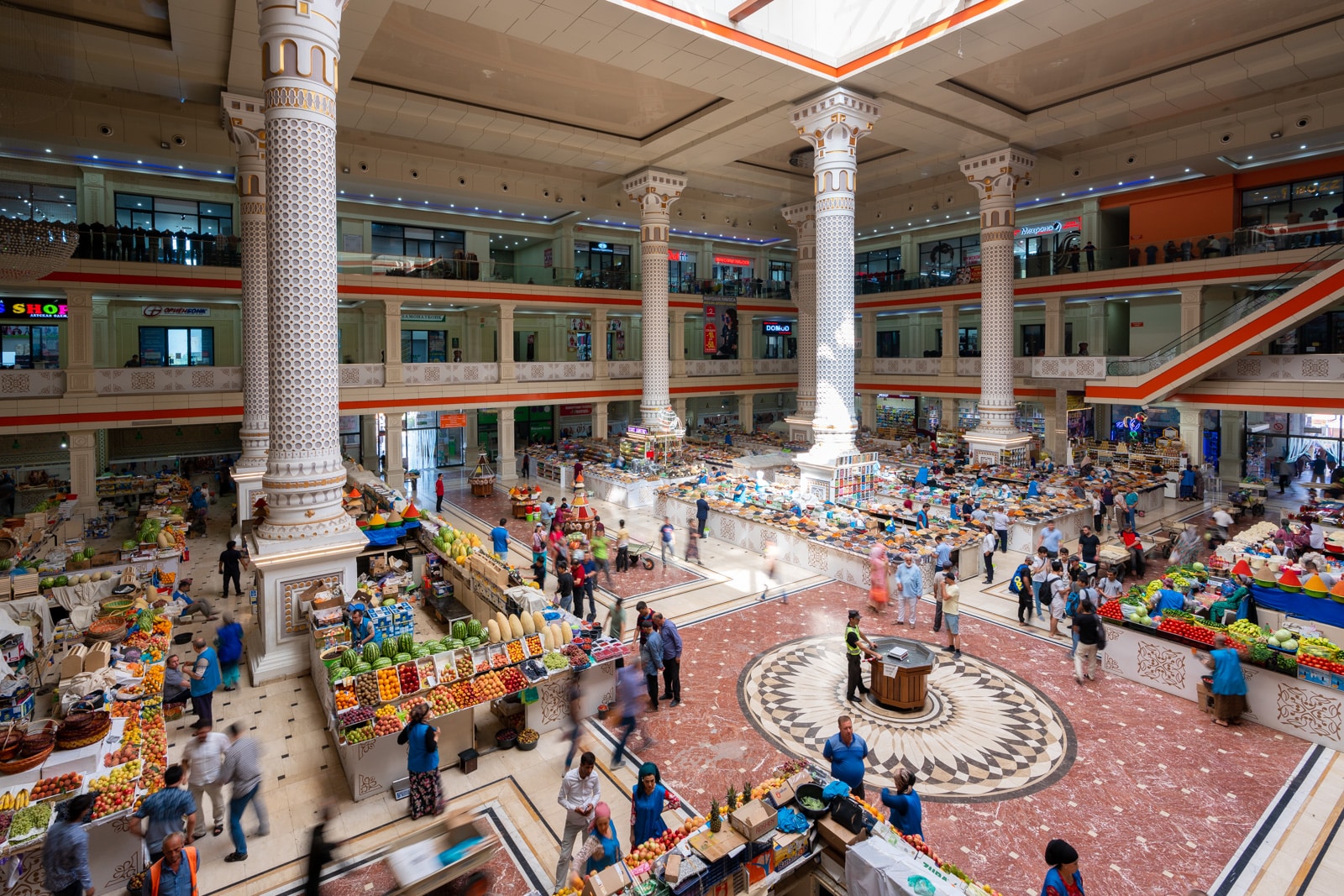
Mehrgon Bazaar
Day 13 | Dushanbe
Dushanbe isn’t huge—you can easily spend this first full day of park hoppin’ and museum chillin’ on foot. But if you’re tired of walking…. $1-2 taxi rides, holla!
Places to visit in Dushanbe
National Museum: I’m not a museum person, but the National Museum has some interesting collections I did enjoy: some of the frescoes from Old Panjakent, and an entire top floor with unique artworks from Tajik artists.
Rudaki Park: Dushanbe’s prettiest park is next to the National Museum. Its tree-lined ways contain everything from Palace of Nations (where the president works) to eccentricities like the second tallest flagpole in the world. Visit after a trip to the museum, but know the park really comes alive at night.
Rohat Chaikhana: Massive teahouse on Rudaki Avenue. Beautifully decorated and a pleasant place to have an affordable nice lunch outside. You can sit in a columned open hall, or an elaborate wooden interior.
Museum of Antiquities: I know, I know, museums. But wait: it contains the bones of the Princess of Sarazm (creepy, but cool), plus an impressive collection of ancient artifacts.
Mehrgon Bazaar: Grand bazaar in the north of the city where you can buy everything from freshly diced carrots to stuffed dried dates.
Ayni Opera & Ballet Theatre: Here you can see operas or ballets in a grand theater for unbeatable prices: US$2 per ticket. Pop in to see if any shows are on!
Sim Sim brewery: Tajikistan’s favorite beer is brewed here in Dushanbe. You can enjoy two varieties of local brew on its rooftop terrace, or in the restaurant below. Food and regional bar snacks are on offer.

Kurutob (with meat) at Olim
Day 14 | Dushanbe
For your final day in Tajikistan, head a bit deeper into Dushanbe.
Places to visit
Chatr Café: Café run by women whose profits support female victims of domestic violence. Great coffee, good ambiance, and who doesn’t want to support women-run businesses?
Botanical Garden: A short walk from Chatr Café, stroll in this sprawling garden where couples and families enjoy days out. However, if you’re not already at the cafe I don’t think it’s worth a trip—there are other parks in Dushanbe.
Kurutobhona Olim: Kurutob is one of the few Central Asian dishes that excite me. Strips of bread, yogurt, salad, and herbs make up this curious but delicious dish (one of the few decent vegetarian options in Tajikistan!). Olim restaurant, outside the city center, is a popular local lunch spot.
Navruz Palace: Kokhi Navruz is an attractive palace on the water that’s been converted to a place for events and entertainment. Its grand halls overflow with woodwork, ceiling frescoes, and tiled mosaics. Visit its interior and/or dine at one of the teahouses by its entrance.
Chavonon Gardens: Lining a lake and beachfront behind Navruz Palace, these small gardens are a popular hangout spot in afternoons and evenings. There’s a small cafe on the water where you can sit and people watch.
Transportation times from Dushanbe
- Taxi to Panjakent: 7 hours
- Taxi to Khujand: 6 hours
- Taxi to Khorog: 14-20 hours
Day trips from Dushanbe
- Hisor Fort: Parts of this fort are 1,000+ years old, but you can’t quite tell: the fort was restored after Russians destroyed it in the 1920s. Nevertheless, it’s a scenic place to walk around, and shares a square with a similarly old-yet-restored madrassa and caravanserai. Head to the fort on weekends; you’re bound to run into Tajik wedding parties! A round trip taxi to the fort should cost ~150 somoni.
- Iskanderkul Lake: Legend has it Alexander the Great’s favorite horse, Bucephalus, died in this lake… and has haunted it since. Though it’s not particularly impressive after the Lakes Loop, it’s the most popular natural getaway from Dushanbe, and is still beautiful. Visit by taxi as a day trip from Dushanbe, or stay overnight at a turbaza, tourist base, which offer simple rooms or Soviet-style cottages.
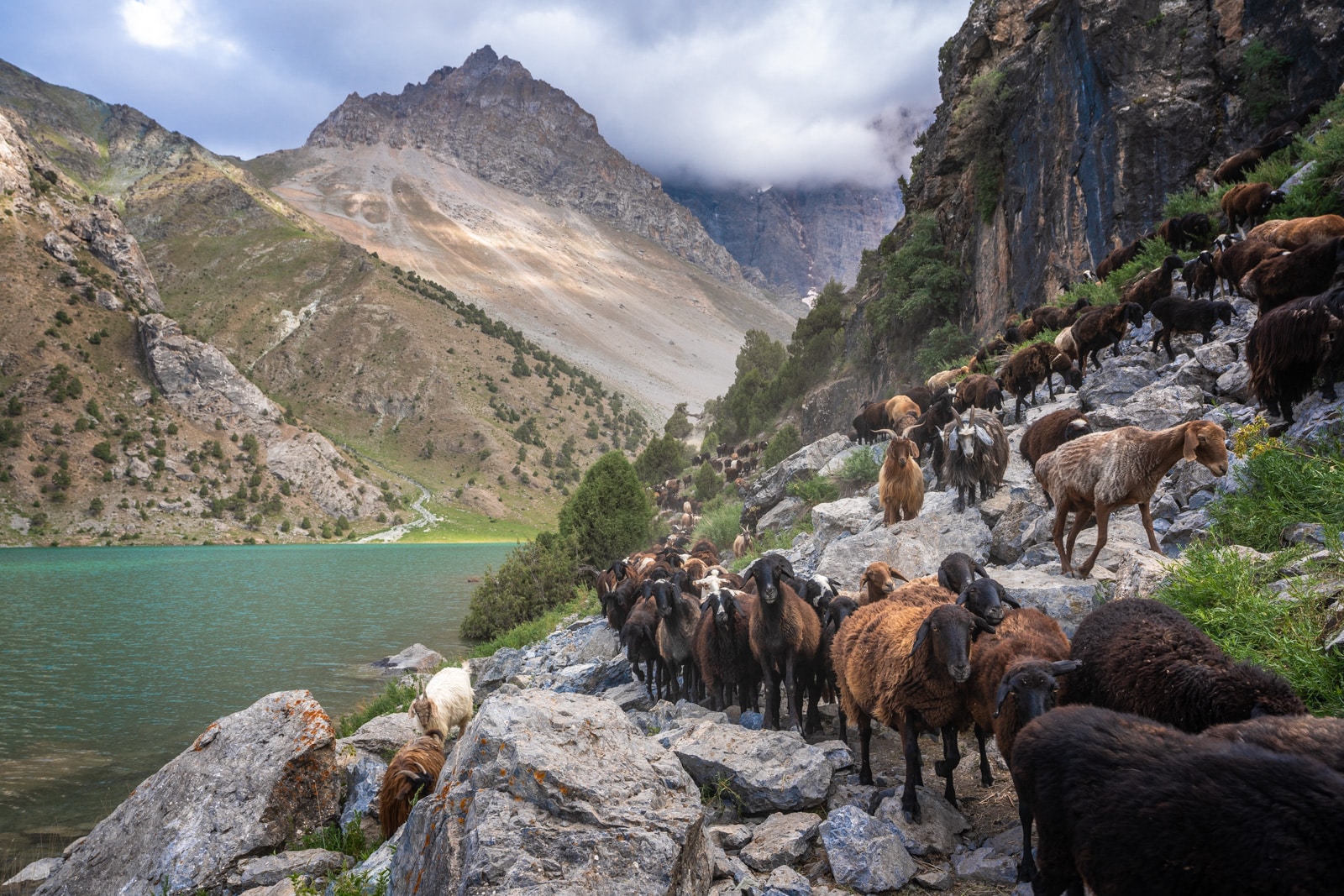
Life on Kulikalon Lake, Tajikistan
Tips for traveling in Uzbekistan and Tajikistan
- Visa free and e-visa schemes are available for both countries. Uzbekistan is now visa-free for many nationalities. Others should apply for an e-visa. Tajikistan offers e-visas to 121 nationalities.
- Both countries are majority Islamic. Though relaxed, you should still dress modestly; cover shoulders and knees.
- Russian is more useful than English. More touristic Uzbekistan has more English-speakers, but as a whole Russian is far more useful than English in Central Asia. Download Google Translate and save Russian as an offline language to use in your travels.
- Get a VPN. Aside from the fact you should always use a VPN while traveling, some websites are also blocked in Uzbekistan and Tajikistan.
- Bring your own trekking gear if possible. Though you can rent gear in Tajikistan, your gear is likely higher quality. You can find gas canisters in Dushanbe and Panjakent.
- Be prepared. Infrastructure is poor outside of Tajikistan’s cities. Traveler’s diarrhea is very common, roads are terrible at times, and electricity is not guaranteed.
- Don’t take photos of sensitive subjects in Uzbekistan. Think infrastructure like tunnels and railways, power plants, guards and military.
- Always carry your passport and visa copy. There are occasional checkpoints where you need to register information.

Shah-i-Zinda, Samarkand
Resources for travel in Uzbekistan and Tajikistan
- Booking.com: Accommodation in Tajikistan and Uzbekistan
- Uzbekistan Travel: Official website of Uzbekistan’s tourism board
- Tajikistan Tourism Portal: Official website of Tajikistan tourism. (Painful, but full of information.)
- ZTDA: Official website of Zeravshan Tourism Development Association. Helpful for finding homestays and transport information in northwest Tajikistan.
- Caravanistan: The holy grail of all things travel in Central Asia.
- Two week Uzbekistan itinerary: Itinerary for just Uzbekistan.
- 60 things to know before traveling Uzbekistan: Tips for Uzbekistan.
- 10 ways to prepare for travel in Tajikistan: Tips for Tajikistan.
- Adventures of Lil Nicki: Travel blogger who’s covered everything in Tajikistan.

Was this helpful? Pin it!
Yay transparency! This post contains affiliate links. If you buy something using my links, I’ll make a bit of cashmonies at no extra cost to you. No worries, I’d never recommend something I wouldn’t actually use. I’m not evil.
Now for the dry stuff: this publication/activity is made possible by the support of the American People through the United States Agency for International Development (USAID) Competitiveness, Trade, and Jobs Activity in Central Asia. The contents of this publication are the sole responsibility of Lost With Purpose (that’s me!) and do not necessarily reflect the views of USAID or the United States Government.



Hello Alex , Thank You for such detailed information .
I was wondering what is a REGISTRATION SLIPS which I have to show at Border Crossings .Is this for all the Stan Countries.
Thanks again
Thank you for your helpful article.
Are there scenic places in Haftkul or similar to Haftkul that can be accessed by vehicle and without trekking?
I am travelling with some older travellers who have mobility issues.
Thanks.